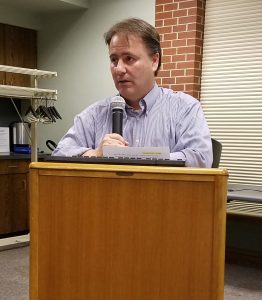 Marshall County’s looking to spend a significant amount of money to bring roads up to a good state of repair, but State Representative Tim Harman says he’s figured out a way to do it without raising taxes. “In 2016, we’re going to spend the $4- to $5-million requested by the Highway Department, using their own funds,” he says. “In 2017 to 2020, we double our current spending, using the surpluses from the jail tax and general funds. In 2021, we literally can triple it at that point because we’re going to raise another $1.1 million.”
Marshall County’s looking to spend a significant amount of money to bring roads up to a good state of repair, but State Representative Tim Harman says he’s figured out a way to do it without raising taxes. “In 2016, we’re going to spend the $4- to $5-million requested by the Highway Department, using their own funds,” he says. “In 2017 to 2020, we double our current spending, using the surpluses from the jail tax and general funds. In 2021, we literally can triple it at that point because we’re going to raise another $1.1 million.”
The Marshall County Council is considering a Local Option Highway User Tax and a County Economic Development Income Tax to provide a long-term road funding solution. However, during a public meeting in Plymouth Thursday, Harman says that money is accumulating in the County Highway Department’s reserves, fueled by increases in state road funding.
To address the county’s immediate needs, he says that the Highway Department’s goal of spending $4- to $5- million this year is attainable using money already available to them, “They already said they’re going to use $850,000 of their own money. We could use the local government rebate. They’re going to get an advance payment from U.S. 31. They could dip into their own reserves. They have $2 million of their own cash right now. I think they can use some of that, spend down some of their cash balance. There’s $4 million right there. That’s all Highway Department money. That’s none of the other county’s money. If they get the matching grant, we’re at $5 million without using any other funds from the county.”
To sustain an increase in road funding over the next five years, Harman recommends using tax revenue intended for the Marshall County Jail. He says that after money collected by the Jail Tax is used for the bond payment on the jail and some of its operating costs, there’s $745,000 left over. With that money, Harman says the county can double its annual road funding. Then in 2021, the jail bond can be paid off, allowing the county to triple its road funding compared to current levels.
This concept can also be taken even further, according to Harman, to fund the county’s economic development efforts. The County Economic Development Income Tax is considered the primary tool for doing that, but Harman says the money can be found instead by dipping into the cash reserves of some of the various taxing districts in Marshall County. These include cities, towns, townships, and libraries.
Harman says at the end of 2015, there was a total over $121 million in surplus money in reserves around the county, and that amount continues to grow. He says that through the increased use of inter-local government agreements, funds can be made available for some of the projects outlined in the Marshall County Vision, like an entrepreneur hub, increased affordable housing, and extension of the Metronet.
Harman believes this method will allow local governments to focus their resources where they’re needed most, “I think a lot of elected officials – I wish they would be a little bit more open because here’s what happening: they tell me, ‘Tim, we don’t really need to spend that money. We didn’t need to spend that money.’ Sometimes, we spend money on things that are nice but not needed, and that’s my concern, that because we have the money, we spend it on things that we don’t need.”
However, some of those in attendance at Thursday’s meeting felt Harmon’s plan is unfair on local units of government that have worked hard to build up their cash reserves for emergencies, as well as planned expenditures. Harman instead focused on the impact to taxpayers, saying he prefers to see existing tax dollars put into use, rather than to go about collecting more.










